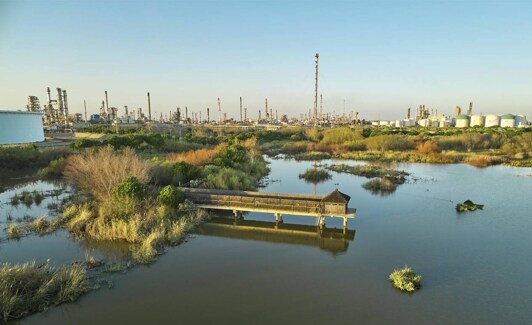The bird that has nested again next to the Cepsa factory in Palos de la Frontera.
SDG 15 | LIFE OF TERRESTRIAL ECOSYSTEMS
The work to recover the natural environment located next to an industrial facility, led by the Cepsa Foundation and the Andalusian Government, has borne fruit with the breeding of this threatened bird
The Cepsa Foundation’s ‘Lagua Primera de Palos’ natural area, adjacent to the industrial facilities and recovered by the energy company more than 20 years ago, has been the scene of breeding pairs of spoonbills, a bird that disappeared from the Palos lagoons de la Frontera 60 years ago. Since then, there had only been one case of nesting in the natural area, but it was not successful.
The appearance of nests with young spoonbills was detected weeks ago by biologists who collaborate with Fundación Cepsa, in charge of maintenance. From that moment on, a nest monitoring plan was activated to determine if the breeding was successful, as it has finally been.
The spoonbill is a wading bird that lives in shallow wetlands, where it tracks the waters with a very sensitive beak – its shape gives it its name – in search of small fish and invertebrates.
It is a species very sensitive to disturbances, so it nests in inaccessible places. At the end of the breeding period, towards the end of July, they migrate south along the Andalusian and Moroccan coast until they reach Mauritania and Senegal (about 3,000 kilometers away), where they remain until December.
Jesús Velasco, head of Fundación Cepsa in Andalusia, points out that the return of the spoonbill can be considered an environmental milestone. «It is a threatened species, we know that more than 90% of its breeding population in Spain is located in Andalusia, mostly in Doñana, followed by Marismas del Odiel. In recent years this population has been decreasing due to the
receding wetlands and the greater contamination of its waters. This fact gives us very valuable information about the suitability of the works that have been carried out in our lagoon, and encourages us to continue working to improve this natural environment that coexists in harmony with our industrial facilities in Huelva.”
Public-private collaboration
The territorial delegate for Sustainable Development of the Junta de Andalucía in Huelva, José Enrique Borrallo, has expressed his satisfaction: “It is a source of pride that we find indicators of biodiversity as important as this from a public-private collaboration.”
The Andalusian delegation has been in charge of carrying out a flight to monitor and survey the situation of reproduction of the birds and has confirmed the presence of a mixed colony with six nests of spoonbills that coexist with specimens of imperial heron, squacco heron, glossy ibis, little egret and little egret.
Fundación Cepsa, in collaboration with the aforementioned Sustainable Development area, has carried out actions for years to improve the reception capacity of aquatic birds to the point of converting the Primera de Palos lagoon into a very attractive space for birds. The islands created have been vital for the regular breeding of rails, ducks, fumarels, white-faced geese and herons, such as imperial and bittern.
Two decades of restoration
Located next to the Cepsa facilities in Palos de la Frontera (Huelva), in 2001 Cepsa promoted the recovery of the original state of this landscape in collaboration with the Andalusian Government. “These two decades of coexistence show how a sustainable balance between industrial development, among other economic sectors, and nature conservation is possible,” they value from Cepsa. The company and its foundation have led numerous research projects, maintenance projects and programs to promote its public use, as well as environmental dissemination and awareness.
www.hoy.es
Eddie is an Australian news reporter with over 9 years in the industry and has published on Forbes and tech crunch.
